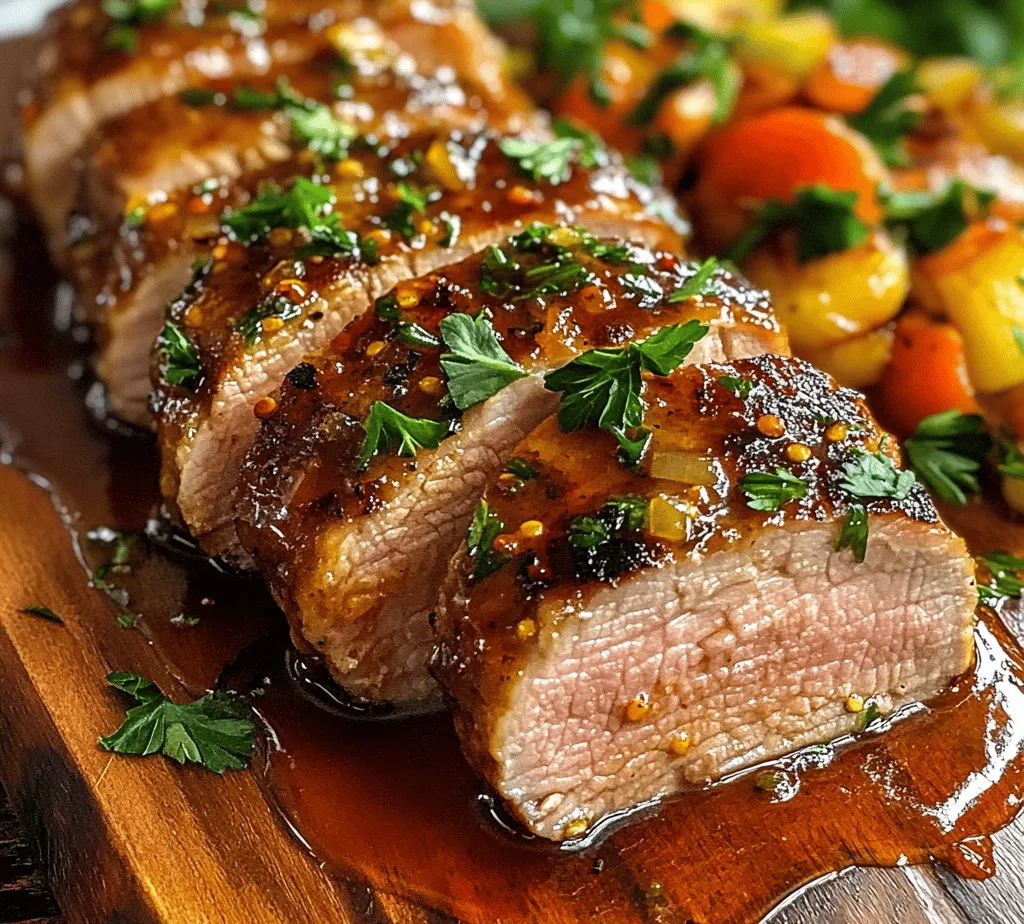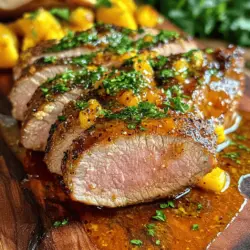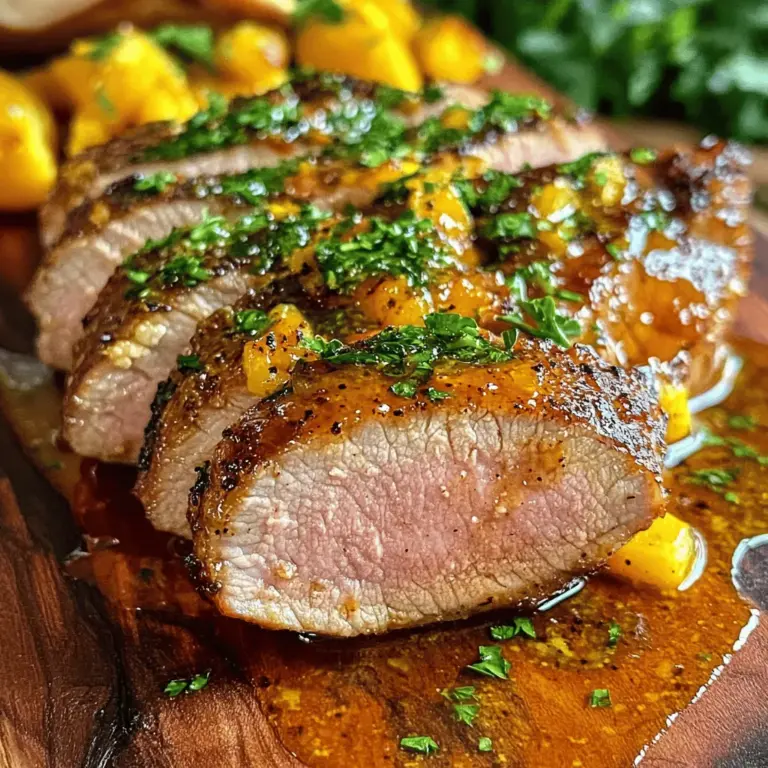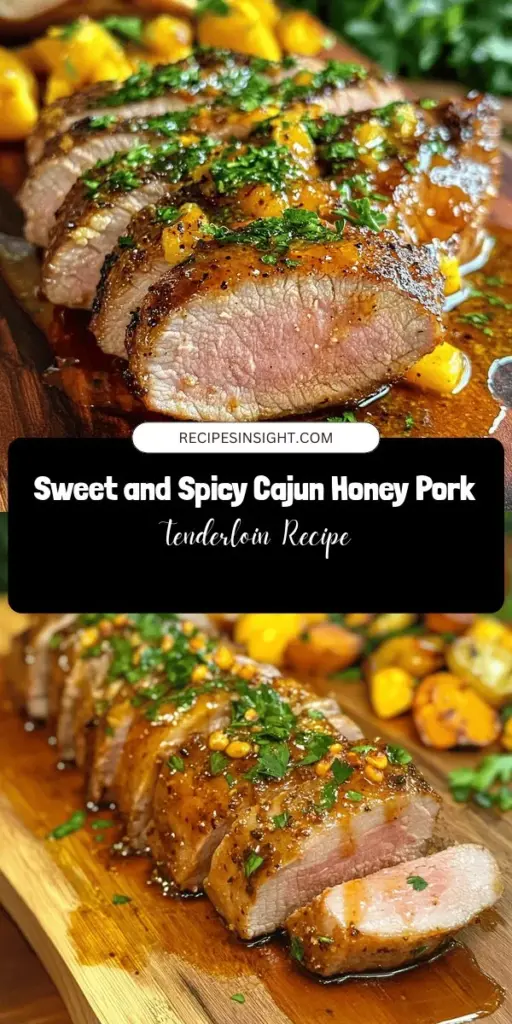Introduction
When it comes to bold flavors and memorable meals, few cuisines can rival the allure of Cajun cooking. With its roots firmly planted in the rich cultural tapestry of Louisiana, Cajun cuisine is a celebration of vibrant ingredients and robust spices. At the heart of this culinary tradition lies the Cajun Honey Pork Tenderloin—a dish that beautifully embodies the fusion of sweet and spicy flavors, tantalizing your taste buds with every bite. This recipe is not only straightforward to prepare but also serves as a stunning centerpiece for any meal, making it a perfect choice for both weeknight dinners and special gatherings.
In this article, we will dive deep into the ingredients that make this dish sing, the preparation steps that ensure optimal flavor infusion, and the cooking techniques that bring the Cajun Honey Pork Tenderloin to life. Whether you are a seasoned chef or a novice in the kitchen, this recipe offers a delightful experience that showcases the unique essence of Cajun spices melded with the richness of honey.
The Appeal of Cajun Cuisine
Delving into the Roots of Cajun Cooking
Cajun cuisine is a melting pot of flavors, influenced by French, Spanish, African, and Native American culinary traditions. Originating from the Acadian people who settled in Louisiana, this style of cooking is characterized by its hearty ingredients and its emphasis on seasoning. The focus on fresh, locally sourced produce, meats, and seafood allows for a variety of dishes that reflect the region’s agricultural bounty.
One of the most distinctive features of Cajun cooking is its use of the “holy trinity”—a blend of onions, bell peppers, and celery—often the base of many dishes. This trio of vegetables provides a depth of flavor that is further enhanced by the addition of spices, creating a rich and inviting atmosphere around the dining table.
Highlighting the Unique Ingredients and Flavors
What sets Cajun cuisine apart is its bold use of spices and herbs. Traditional Cajun seasoning blends often include paprika, cayenne pepper, garlic powder, and oregano, among other spices, which create a complex flavor profile that can be both spicy and aromatic. These seasonings not only enhance the taste of dishes but also carry cultural significance, telling the story of the region’s history and the people who inhabit it.
The beauty of Cajun cooking lies in its versatility. While many recipes feature meat as the main component, there is an abundance of vegetarian and seafood options that showcase the region’s diverse ingredients. This adaptability makes Cajun cuisine appealing to a wide range of palates, encouraging exploration and experimentation in the kitchen.
Understanding the Cultural Significance of Spices in Cajun Dishes
Spices are not merely flavoring agents in Cajun dishes; they are integral to the culinary identity of the region. Each spice carries its own history and significance, often passed down through generations of home cooks. The use of cayenne pepper, for instance, reflects the bold spirit of the Cajun people, while thyme and bay leaves add aromatic depth, reminiscent of the lush, natural landscapes of Louisiana.
In Cajun cooking, spices also serve a practical purpose. The heat from spices can help preserve meats and enhance their flavor, making them a staple in dishes that celebrate the bounty of the land. This connection to tradition and the environment is what makes Cajun cuisine not just a style of cooking, but a way of life for many in the region.
Ingredient Breakdown
The Star Ingredient: Pork Tenderloin
When it comes to the Cajun Honey Pork Tenderloin, the star of the show is undoubtedly the pork tenderloin. This cut of meat is prized for its tenderness and mild flavor, making it an excellent canvas for the bold Cajun spices and sweet honey glaze. Pork tenderloin is lean, cooks quickly, and stays juicy when prepared correctly, making it a favorite among home cooks and chefs alike.
Choosing the right pork tenderloin is crucial for the success of this dish. Look for a fresh cut with minimal fat and a firm texture, as this will ensure a tender and flavorful result. The beauty of pork tenderloin is that it readily absorbs marinades and seasonings, allowing for a delightful interplay of flavors in every bite.
Exploring the Role of Cajun Seasoning
Cajun seasoning is the cornerstone of this recipe, infusing the pork with a punch of flavor that is both spicy and aromatic. A good Cajun seasoning blend typically contains a mix of paprika, garlic powder, onion powder, cayenne pepper, and various herbs like thyme and oregano. You can either purchase a premade blend from the store or create your own at home using individual spices.
The key to a successful Cajun Honey Pork Tenderloin lies in the balance of flavors. The heat from the spices should harmonize with the sweetness of the honey, creating a dish that is complex yet approachable. When selecting or making your Cajun seasoning, aim for a blend that suits your personal taste preferences, adjusting the heat level as desired.
The Importance of Honey in Balancing Flavors
Honey is the secret weapon in this recipe, providing a natural sweetness that beautifully complements the spicy Cajun seasoning. Its unique flavor not only enhances the overall taste of the dish but also helps to create a caramelized crust when the pork is cooked.
Using high-quality honey is essential for achieving the best flavor. Opt for raw or locally sourced honey, as it often has a more robust taste and can add subtle floral notes to the dish. The sweetness of honey also serves to balance the heat from the spices, making the dish enjoyable for those who may be sensitive to spiciness.
The Function of Soy Sauce and Apple Cider Vinegar in Marinades
In addition to Cajun seasoning and honey, this recipe calls for soy sauce and apple cider vinegar, which play vital roles in the marinade. Soy sauce adds umami depth and enhances the savory notes of the pork, while apple cider vinegar provides acidity, helping to tenderize the meat and brighten the overall flavor profile.
Together, these ingredients create a marinade that penetrates the pork, ensuring that every bite is bursting with flavor. When marinating, it’s essential to allow enough time for the flavors to meld and infuse the meat fully. This step not only enhances the taste but also helps to achieve a tender and juicy pork tenderloin.
Highlighting Garlic, Smoked Paprika, Black Pepper, and Salt
Garlic is a key player in this recipe, adding a savory depth that complements the sweetness of the honey and the heat of the spices. Fresh garlic cloves, minced or crushed, will provide the best flavor, though garlic powder can also work in a pinch.
Smoked paprika brings an additional layer of flavor, imparting a subtle smokiness that enhances the overall taste of the dish. This ingredient is essential for creating a well-rounded flavor profile that reflects the essence of Cajun cooking.
Black pepper and salt are fundamental seasonings that enhance all the other ingredients. A good sprinkle of freshly cracked black pepper will add warmth and complexity, while salt is crucial for drawing out moisture and amplifying the flavors in the dish.
Using Fresh Parsley as a Garnish: Benefits and Flavor Enhancement
To finish off the Cajun Honey Pork Tenderloin, a sprinkle of fresh parsley serves as a vibrant garnish. Not only does it add a pop of color to the dish, but it also provides a fresh, herbal note that balances the richness of the pork and honey glaze.
Fresh parsley is known for its antioxidant properties and is a great source of vitamins A, C, and K. Including this garnish not only enhances the visual appeal but also adds a healthful element to your meal. Simply chop the parsley finely and sprinkle it over the finished dish for a beautiful presentation.
Preparation Steps for Cajun Honey Pork Tenderloin
Marinating the Pork: Best Practices for Flavor Infusion
To achieve the best flavor and tenderness from your Cajun Honey Pork Tenderloin, marinating is essential. Begin by combining all the marinade ingredients—Cajun seasoning, honey, soy sauce, apple cider vinegar, minced garlic, and smoked paprika—in a mixing bowl. Whisk together until well combined, ensuring that the honey is fully incorporated into the mixture.
Once the marinade is prepared, place the pork tenderloin in a resealable plastic bag or a shallow dish. Pour the marinade over the pork, making sure it is evenly coated. Seal the bag or cover the dish and refrigerate for at least 1 hour, though marinating overnight will yield even better results.
The Science Behind Marinating and Resting Times
Marinating is not just about flavor; it also serves a scientific purpose. The acidity from the vinegar, combined with the salt in the soy sauce, helps to break down the proteins in the pork, making it more tender. The longer the pork marinates, the more flavor it absorbs. However, it’s essential to find a balance, as marinating for too long can lead to mushy meat.
After marinating, let the pork sit at room temperature for about 30 minutes before cooking. This resting time allows the meat to come to a more even temperature, ensuring that it cooks uniformly and retains moisture during the cooking process.
By following these preparation steps, you are well on your way to creating a Cajun Honey Pork Tenderloin that is flavorful, tender, and sure to impress. In the next section, we will delve into the cooking techniques that will elevate this dish to its full potential, providing you with the tools you need to achieve a stunning and delicious result.

Choosing the Right Tools: Skillet vs. Oven-Safe Cookware
When it comes to preparing Cajun Honey Pork Tenderloin, selecting the right cookware is essential for achieving optimal results. You have a couple of great options: a heavy skillet or oven-safe cookware.
Skillet: A cast-iron skillet is an excellent choice for searing the pork. Its ability to retain heat ensures that you achieve a beautiful golden crust, which is crucial for flavor development. When using a skillet, make sure it’s well-seasoned to prevent sticking and promote even cooking.
Oven-Safe Cookware: If you prefer a one-pan method, an oven-safe dish can be a great alternative. You can start by searing the pork on the stovetop to get that crust and then transfer it directly to the oven to finish cooking. This method is convenient and minimizes cleanup, allowing you to focus on other aspects of your meal.
Tips on Ensuring Even Cooking and Achieving the Perfect Crust
Achieving that perfect crust while ensuring even cooking can be a bit tricky but with the right techniques, it’s certainly manageable. Here are some tips to help you master this:
1. Pat Dry: Before seasoning, make sure to pat the pork tenderloin dry with paper towels. This step removes excess moisture, allowing for a better sear.
2. Room Temperature: Let the pork tenderloin sit at room temperature for about 30 minutes before cooking. This practice promotes even cooking throughout the meat.
3. Searing Technique: Heat your skillet or oven-safe cookware over medium-high heat and add a splash of oil. Once the oil is shimmering, place the pork in the pan. Avoid overcrowding the pan to ensure that the meat sears rather than steams.
4. Do Not Move It: After placing the pork in the pan, let it sear without moving it for several minutes. This will help develop a crust. Only flip it once you see that it has released easily from the pan.
5. Monitor Heat Levels: If you notice the pork is browning too quickly, reduce the heat slightly. Adjusting the heat ensures that the crust forms without burning while allowing the interior to cook through.
Cooking Techniques for Optimal Results
Searing the Pork: Importance of Achieving a Golden Brown Crust
The searing process is critical in developing flavor. When you sear the pork tenderloin, the Maillard reaction occurs, which is a chemical reaction between amino acids and reducing sugars that gives browned foods their distinctive flavor. This deep, savory crust enhances the overall taste of your Cajun Honey Pork Tenderloin, making it an essential step in the cooking process.
Understanding the Temperature Dynamics of Cooking Pork
Pork tenderloin is best cooked to an internal temperature of 145°F (63°C) for optimal tenderness and flavor. Cooking it beyond this temperature can lead to dryness. As the pork cooks, the heat will penetrate the meat, so understanding how heat transfers can help you avoid overcooking. It is advisable to remove the meat from heat when it reaches about 140°F (60°C) since it will continue to cook slightly while resting.
How to Use a Meat Thermometer Effectively
A reliable meat thermometer is a vital tool for ensuring perfectly cooked pork. Insert the thermometer into the thickest part of the tenderloin, avoiding any bones or the pan itself. This technique will give you the most accurate reading. For best results, ensure your thermometer is calibrated and capable of reading temperatures accurately to avoid undercooking or overcooking.
The Resting Phase: Why It’s Crucial for Juiciness and Flavor Retention
After cooking, it’s essential to let your Cajun Honey Pork Tenderloin rest for at least 5-10 minutes before slicing. This resting phase allows the juices to redistribute throughout the meat, resulting in a juicier and more flavorful dish. If you slice it too quickly, the juices will escape, leading to dryness. Cover the tenderloin loosely with foil during this resting period to keep it warm.
Serving Suggestions and Pairings
Once your Cajun Honey Pork Tenderloin is beautifully cooked and rested, it’s time to serve! Here are some ideal side dishes and pairings that will complement the rich flavors of the pork.
Ideal Side Dishes to Complement the Cajun Honey Pork Tenderloin
1. Roasted Vegetables: Seasonal vegetables like Brussels sprouts, carrots, or sweet potatoes roasted with olive oil, salt, and pepper provide a delightful contrast to the sweetness of the honey glaze.
2. Cajun Rice: A fluffy Cajun-style rice with spices and herbs not only adds flavor but also helps soak up the delicious juices from the pork.
3. Cornbread: The sweetness of cornbread pairs perfectly with the spicy notes of Cajun cuisine, making it an excellent addition to your meal.
Creating a Balanced Meal: Suggested Salads and Starches
For a balanced meal, consider adding a fresh salad or starch:
– Mixed Greens Salad: Toss together mixed greens, cherry tomatoes, cucumber, and a light vinaigrette for a refreshing contrast to the rich pork.
– Garlic Mashed Potatoes: Creamy garlic mashed potatoes offer a comforting side that complements the spiciness of the dish beautifully.
Wine and Beverage Pairings for a Complete Dining Experience
To enhance your dining experience, consider pairing your Cajun Honey Pork Tenderloin with the following beverages:
– White Wine: A chilled Sauvignon Blanc or a lightly oaked Chardonnay can balance the sweetness and spice of the dish.
– Red Wine: A medium-bodied red, such as a Pinot Noir or Grenache, can complement the flavors without overpowering the dish.
– Craft Beer: If you prefer beer, a hoppy IPA or a malty amber ale can provide a nice contrast to the pork.
Nutritional Analysis
Understanding the nutritional aspects of your meal can help you enjoy it more mindfully. Here’s a brief nutritional analysis of Cajun Honey Pork Tenderloin.
Caloric Breakdown of the Dish
A standard serving of Cajun Honey Pork Tenderloin (about 4 ounces) contains approximately:
– Calories: 250-300
– Protein: 30g
– Fat: 10g
– Carbohydrates: 10g
These values may vary depending on the specific ingredients and cooking methods used.
Discussing the Health Benefits of Pork Tenderloin
Pork tenderloin is one of the leanest cuts of pork and is an excellent source of high-quality protein. It contains essential vitamins and minerals, including B vitamins (especially B6 and B12), zinc, and selenium. These nutrients support energy metabolism, immune function, and overall health.
Analyzing the Impact of the Marinade Ingredients on Nutrition
The marinade used in the Cajun Honey Pork Tenderloin, which includes honey, Dijon mustard, and spices, adds flavor without excessive calories. Honey provides natural sweetness and antioxidants, while spices like paprika and cayenne pepper are known for their potential health benefits, including anti-inflammatory properties.
Conclusion
In conclusion, the Cajun Honey Pork Tenderloin is a delightful dish that embodies the essence of Cajun cooking while offering a sweet twist that makes it accessible to all palates. The combination of spices and honey creates a flavor profile that is both exciting and comforting, perfect for gatherings or a cozy family dinner. With straightforward preparation and cooking techniques, this recipe will surely become a favorite in your culinary repertoire.
As you master the art of cooking this dish, remember to savor the process as much as the results. The joy of cooking lies in both the flavors you create and the memories you make around the dining table. So gather your loved ones, serve up your Cajun Honey Pork Tenderloin, and enjoy a meal that is sure to impress.


